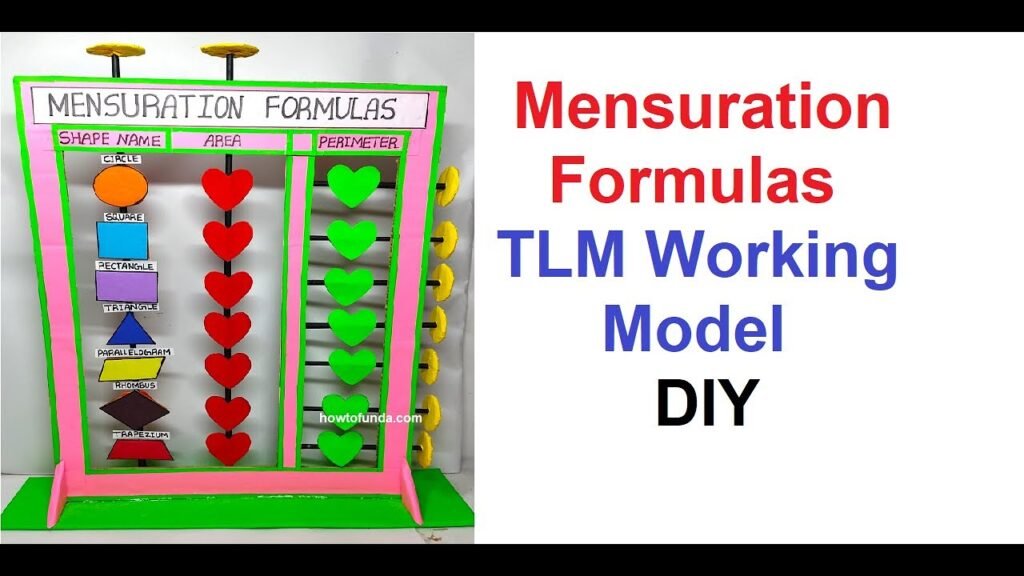Creating a working model for teaching mensuration formulas can be a highly effective Teaching Learning Material (TLM). Here are some ideas and instructions on how to make a comprehensive, interactive model that helps students understand and apply various mensuration formulas:

Materials Needed
- Cardboard
- Scissors
- Glue
- Markers
- Ruler
- Protractor
- String
- Compass
- Transparent plastic sheet (optional)
- Small whiteboard or cardboard for writing formulas
- Colored paper or felt
Step-by-Step Video Instructions
2D Shapes Model
- Square:
- Cut out a square from cardboard.
- Write the formulas for the area (A = side²) and perimeter (P = 4 × side) on a small piece of paper or cardboard.
- Attach the formulas to the square.
- Rectangle:
- Cut out a rectangle from cardboard.
- Write the formulas for the area (A = length × breadth) and perimeter (P = 2 × (length + breadth)).
- Triangle:
- Cut out a triangle from cardboard.
- Write the formulas for the area (A = ½ × base × height) and perimeter (P = a + b + c), and Heron’s formula (A = √[s(s-a)(s-b)(s-c)], where s = (a+b+c)/2).
- Circle:
- Cut out a circle from cardboard using a compass.
- Write the formulas for the area (A = πr²) and circumference (C = 2πr).
3D Shapes Model
- Cube:
- Construct a cube using cardboard.
- Write the formulas for the surface area (SA = 6a²) and volume (V = a³).
- Cuboid:
- Construct a cuboid using cardboard.
- Write the formulas for the surface area (SA = 2(lb + bh + hl)) and volume (V = lbh).
- Cylinder:
- Construct a cylinder using cardboard for the curved surface and circles for the bases.
- Write the formulas for the surface area (SA = 2πr(h + r)) and volume (V = πr²h).
- Cone:
- Construct a cone using cardboard for the curved surface and a circle for the base.
- Write the formulas for the surface area (SA = πr(r + l), where l is the slant height) and volume (V = ⅓πr²h).
- Sphere:
- Use a Styrofoam ball or construct a sphere from cardboard.
- Write the formulas for the surface area (SA = 4πr²) and volume (V = ⅘πr³).
- Pyramid:
- Construct a pyramid using cardboard.
- Write the formulas for the surface area (SA = B + ½Pl, where B is the base area, P is the perimeter of the base, and l is the slant height) and volume (V = ⅓Bh, where B is the base area and h is the height).
Assembly and Presentation
- Base Board: Use a large cardboard sheet as the base.
- Attach each shape with its corresponding formulas on the base board.
- Arrange 2D shapes on one side and 3D shapes on the other for better organization.
- Interactive Elements:
- Use Velcro or magnets to make shapes detachable so students can handle and explore them.
- Add flaps or sliders to cover and reveal formulas for an interactive quiz feature.
- Formula Display:
- Use a small whiteboard or a piece of cardboard to write and explain the formulas.
- Attach this to the base board for easy reference.
- Color Coding:
- Use different colors for different shapes to make the model visually appealing and easier to understand.
- Color-code the formulas to match the shapes.
By creating these interactive and visually engaging models, you can make learning mensuration concepts more accessible and enjoyable for students.

